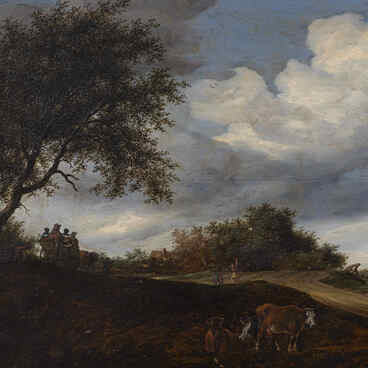Juriaen Jacobsen, also known as Jurien Jacobsz, was a German painter who worked in the tradition of the Flemish school of painting.
The artist was born in the 1620s in Hamburg, where he lived throughout his childhood and adolescence. Then he moved to Flanders and became an apprentice to the brilliant painter of still life and hunting scenes, Frans Snyders. Jacobsz worked for a long time with his teacher, using his paintings as examples. Some of Jacobsz’ famous works appear stiff and rigid, which, along with the artificially rendered forms, shows that the artist painted from other people’s canvases rather than from life.
After Flanders, Jacobsen moved to Amsterdam, where he began to work with the Dutch painter Ferdinand Bohl. A number of portraits created by the German painter during that period reveal Bohl’s influence. Jacobsen’s last place of residence and work was the Dutch town of Leeuwarden.
In general, Jacobsen’s style was noticeably changing under the influence of famous masters, his art was inconsistent, there were attempts to imitate other artists. The artist tried different genres, but his portraits and historical scenes were considered by critics to be rather weak works, unlike his animalistic paintings.
The large-scale painting “A Boar Hunt” is one of the many baroque “hunts” created by Jacobsen following the lead of his teacher, Snyders. The artist traditionally depicts a group of furious dogs forming a closed circle with their adversary, a huge boar, inside the circle. Barking dogs rush at the hunted beast from all sides. Jacobsen directs the viewer’s gaze in a “circular detour”: from one dog figure to another. The boar looks powerful and large — a worthy opponent of the hunting hounds, some of which have already suffered in the fight.
The action unfolds in the foreground, but the figure of the boar almost merges with the dark brown background. In the distance there is a gloomy, gray and thunderous sky, intended to emphasize the baroque drama of the animal fight. The dogs are painted as vividly and varied as possible within the boundaries of the brown and ochre palette.
The pieces depicting dogs attacking a wild boar are among Jacobsen’s most successful works. He created a whole series of such paintings: one of them is kept in the Dresden Gallery, another one is in the Copenhagen Museum.
The artist was born in the 1620s in Hamburg, where he lived throughout his childhood and adolescence. Then he moved to Flanders and became an apprentice to the brilliant painter of still life and hunting scenes, Frans Snyders. Jacobsz worked for a long time with his teacher, using his paintings as examples. Some of Jacobsz’ famous works appear stiff and rigid, which, along with the artificially rendered forms, shows that the artist painted from other people’s canvases rather than from life.
After Flanders, Jacobsen moved to Amsterdam, where he began to work with the Dutch painter Ferdinand Bohl. A number of portraits created by the German painter during that period reveal Bohl’s influence. Jacobsen’s last place of residence and work was the Dutch town of Leeuwarden.
In general, Jacobsen’s style was noticeably changing under the influence of famous masters, his art was inconsistent, there were attempts to imitate other artists. The artist tried different genres, but his portraits and historical scenes were considered by critics to be rather weak works, unlike his animalistic paintings.
The large-scale painting “A Boar Hunt” is one of the many baroque “hunts” created by Jacobsen following the lead of his teacher, Snyders. The artist traditionally depicts a group of furious dogs forming a closed circle with their adversary, a huge boar, inside the circle. Barking dogs rush at the hunted beast from all sides. Jacobsen directs the viewer’s gaze in a “circular detour”: from one dog figure to another. The boar looks powerful and large — a worthy opponent of the hunting hounds, some of which have already suffered in the fight.
The action unfolds in the foreground, but the figure of the boar almost merges with the dark brown background. In the distance there is a gloomy, gray and thunderous sky, intended to emphasize the baroque drama of the animal fight. The dogs are painted as vividly and varied as possible within the boundaries of the brown and ochre palette.
The pieces depicting dogs attacking a wild boar are among Jacobsen’s most successful works. He created a whole series of such paintings: one of them is kept in the Dresden Gallery, another one is in the Copenhagen Museum.


